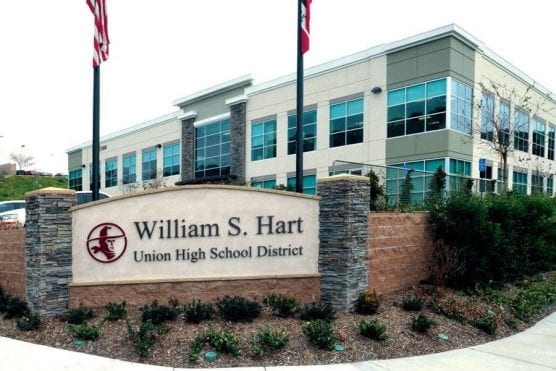During another informational session Wednesday on the Hart High School Indians mascot, the William S. Hart Union High School District’s board heard from a representative of the Fernandeño Tataviam Band of Mission Indians.
While no decision was made on Wednesday night by the board, Rudy Ortega, the tribal president of the Fernandeño Tataviam Band of Mission Indians, informed the trustees he attended the meeting with the hope of moving the dialogue about this issue forward, but said the mascot gives an inaccurate representation of local Native American culture and tradition.
Ortega’s presentation began with a brief outline of a painful history for the indigenous people here in Los Angeles County, beginning with the Spanish conquest and how still to this day the reclamation of many of the local tribes’ traditions and culture continues to be a struggle.
Ortega said his lineage can be traced back to a number of tribes, including those that were located in Towsley Canyon and near where Magic Mountain theme park sits presently today before many of them were forced to move, convert to Catholicism and/or be baptized.
“We rapidly became refugees on our own homelands,” said Ortega. “We had to pretty much erase who we are as Indian people; it wasn’t ‘kosher’ to be called Indian at a time.”
“Change comes and education comes along with it,” said Ortega, in explanation for why this issue remained important to his tribe and many others like it. “Today, my tribe is still arguing and positioning ourselves to show our existence still here; and we’re petitioning for federal acknowledgement.”
Turning specifically to the Hart mascot, Ortega said his tribe had not sought out the students, but it was they, as well as governing board members, who came to the tribes.
The tribes understand history and how the mascot’s tradition has meaning for Hart High alumni — however, the tribes also have had to work for decades to reinstill religious and cultural practices and teach younger generations their endangered languages and history, Ortega said, adding these types of inaccurate representations can present hurdles in that effort.
One example Ortega gave of the obstacles faced in regard to the Hart High mascot is when young Native American students attend the school, the mascot is depicted with regalia more associated with Plains Indians, as opposed to the local tribes.
“I know many of my tribal people who live in Santa Clarita will (eventually become) Hart High School students. And so when they get there, they should be fairly proud of their heritage, the culture and who they are as native people, along with many other students who attend that school, as well,” Ortega said. “We want a correction because as we’re recapturing and educating our own children and our own tribe, they don’t get an understanding, if you’re going to Hart and you want to honor Tataviam people and yet you have a Plains regalia and so on. That doesn’t give a true representation of who we are as tribal people.”
Board member Linda Storli asked about the general feeling among tribes about the racially based mascot, to which Ortega said, “The majority of tribes in California are in support of replacing mascots.”
“I’m being transparent and honest — there are maybe very few tribes that may be supportive of keeping the name Indian on there,” said Ortega.
When asked by board member Joe Messina if there was a teachable moment for students by using the Indian mascot, Ortega said there was both not enough being done to inform students about ethnic studies in California schools and that he didn’t believe a mascot is capable of correctly bringing education and awareness.
During the public comment portion of the meeting, members of the community wrote in letters to voice their support for changing the mascot, while others said taking away the mascot would be erasing history. After hearing from Ortega, board President Cherise Moore reminded attendees the board would likely not be making a decision for several months.
“We are continuing to listen, to learn and we are also looking at ways in which we can engage the student community at Hart High School, the teacher, faculty and staff community at Hart High School, and the community who is impacted by what happens at Hart High School,” Moore said, adding she hopes these conversations would lead to empathy and further understanding.
She added there would be further opportunities for students, district staff and community stakeholders to join the conversation.
Like this:
Like Loading...
Related





 Tweet This
Tweet This Facebook
Facebook Digg This
Digg This Bookmark
Bookmark Stumble
Stumble RSS
RSS



























REAL NAMES ONLY: All posters must use their real individual or business name. This applies equally to Twitter account holders who use a nickname.
0 Comments
You can be the first one to leave a comment.